The state of Wisconsin is known for its snowy winters and dairy production. Much of this area is relatively rural, so wild animals thrive in this place. You’ll find cougars, wolves, and rattlesnakes, along with smaller critters, including spiders. While most of these arachnids are quite small, some of them are very large. The focus of this article is going to be the biggest spiders in Wisconsin, and we’ll tell you all about them.
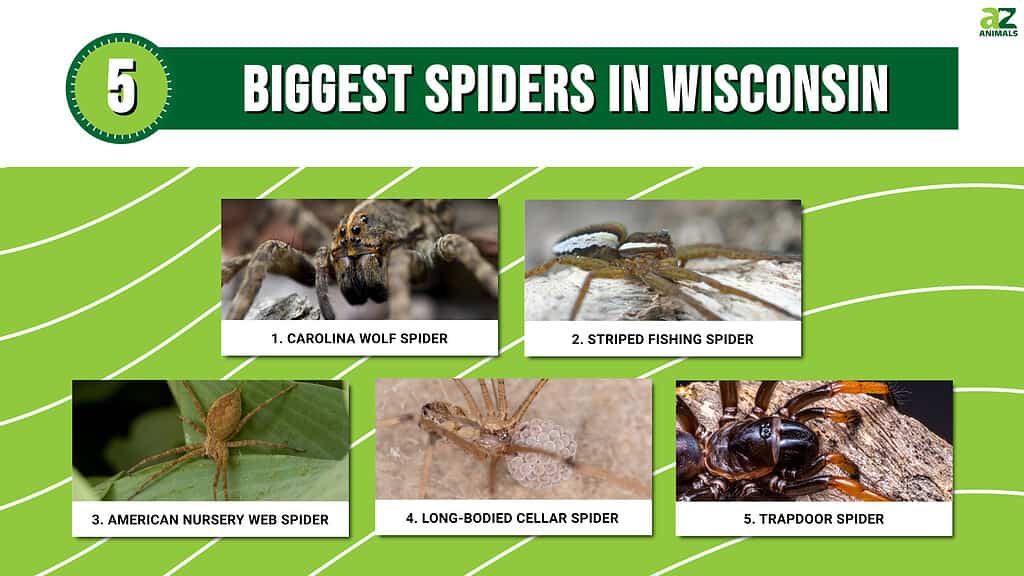
What Are The Biggest Spiders In Wisconsin?
Like most other states, you’ll find that the biggest spiders in Wisconsin are inevitably fishing spiders and wolf spiders. They may be the largest, but they’re not the only big ones in the state. We’ll count down five of the most sizable spiders and tell you where they live, what they look like, and what danger they pose to a human being.
5. Trapdoor Spider
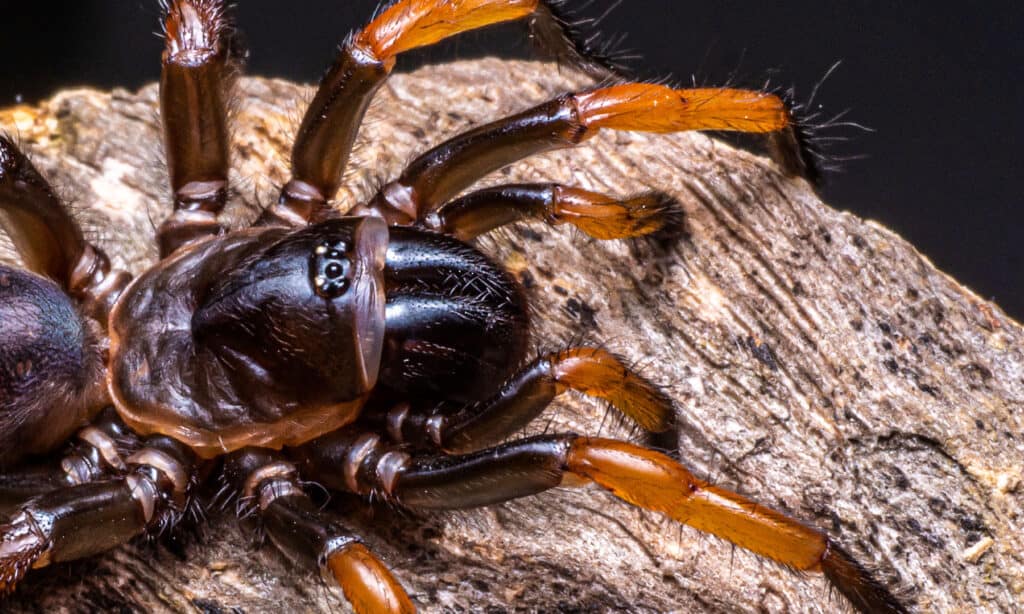
Trapdoor spiders have strong legs to help them dig burrows.
©nokkaew/Shutterstock.com
| Scientific Name | Size | Danger to Humans |
|---|---|---|
| Ummidia Genus | 1-2 inches | Delivers a mildly painful bite. |
The trapdoor spider is rarely seen by humans. It spends most of its time living in burrows or making new ones. These web-lined homes are capped with a hinged door. When prey wanders by, the spider flings the door open and then snatches the hapless prey.
The trapdoor spider is often dark brown or black, with shiny carapaces and legs along with a velvety-looking abdomen. It can resemble a tarantula but is much smaller since it only measures about 2 inches long. This spider lives in forests, tall vegetation, and other out-of-the-way areas.
If you manage to get bitten by one, you’ll feel mild pain due to the fangs, but the pain will quickly dissipate in most cases.
4. Long-Bodied Cellar Spider
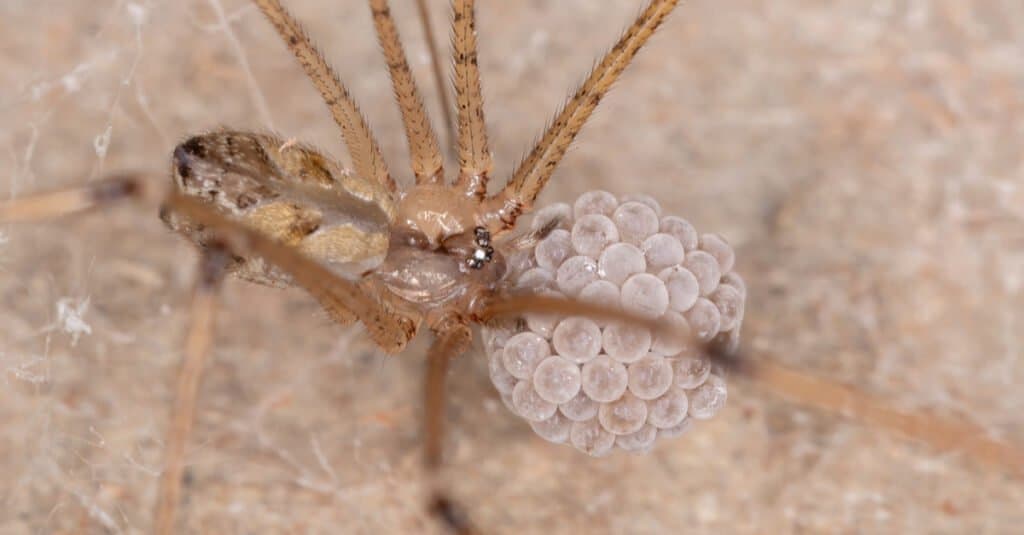
Cellar spiders are scary-looking but otherwise harmless.
©iStock.com/ViniSouza128
| Scientific Name | Size | Danger to Humans |
|---|---|---|
| Pholcus phalangioides | 1-2 inches | A bite may cause a mild burning sensation. |
The cellar spider is that creepy-looking, long-legged spider that lives in the rafters of your garage and the corners of your basements. It usually has a brownish-gray, tan, or light brown body that looks see-through. It has a dark spot on its carapace that some say resembles a skull, hence the other common name, the skull spider.
These creatures are relatively harmless to humans, only capable of inflicting a mildly painful bite that leaves a burning sensation. However, they are very effective hunters that can kill larger and deadlier spiders, including black widows.
The cellar spider’s venom is believed to be more potent than it is due to its habit of hunting other spiders. The truth is that the venom is not all that strong. They’re just very capable hunters with good webs.
3. American Nursery Web Spider
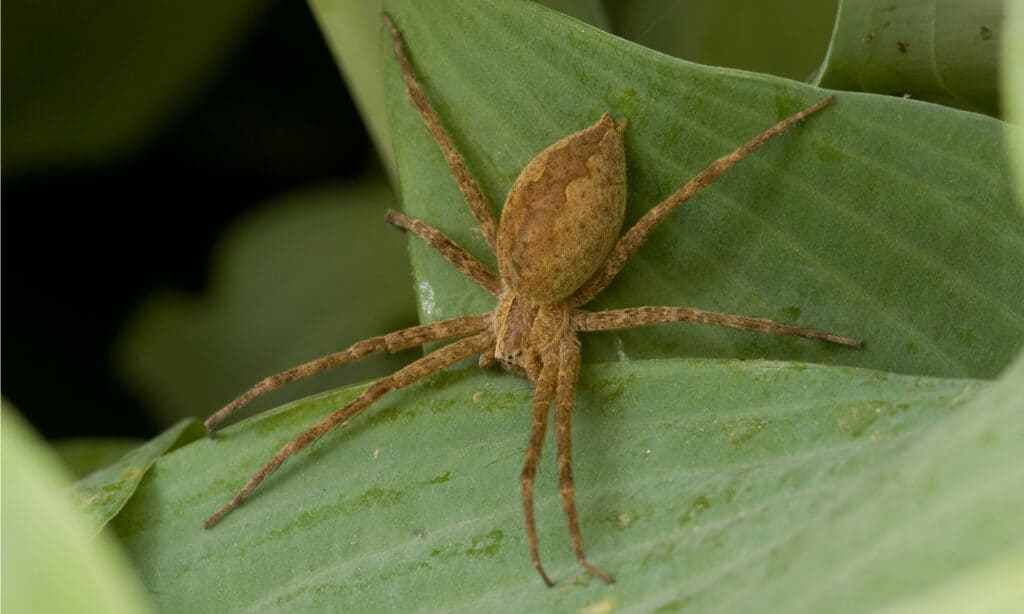
American nursery web spiders have many interesting behaviors, such as cannibalism.
©SDeming/Shutterstock.com
| Scientific Name | Size | Danger to Humans |
|---|---|---|
| Pisaurina mira | 1-3 inches | Delivers a bite that is mostly harmless to humans, with pain and swelling common. |
The American nursery web spider is a rather common large arachnid throughout most of the U.S. This spider usually spends most of its time living in tall vegetation that is found in forests and fields. It can also live in bushes and grass.
These spiders can resemble some types of wolf spiders. They can measure up to 3 inches long, including their legs, and they have a brown body. The nursery web spider’s body is light brown, brown, or reddish brown. It has a darker stripe running the length of the body along with a slightly dark patch inside of that on the abdomen.
This creature is well-known by spider lovers because it lovingly makes a nursery for its young, and the females attempt to eat the males with which they mate.
2. Striped Fishing Spider
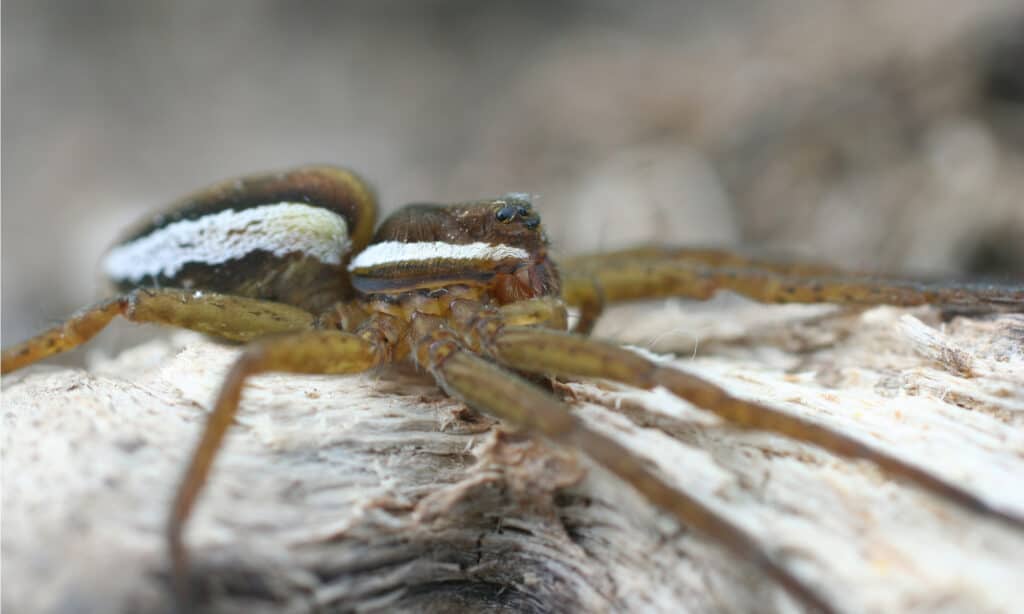
Striped fishing spiders are not as large as other members of their genus.
©Oleg Nikonov/Shutterstock.com
| Scientific Name | Size | Danger to Humans |
|---|---|---|
| Dolomedes scriptus | 1- 2.4 inches | A bite can cause pain and swelling much like a bee or wasp sting or bite. |
The striped fishing spider is a fairly large specimen that can measure over 2 inches long. It is often seen skittering across the water since it can both walk on it and dive below its surface. This species is often found on boats, docks, and piers as it waits to see the many types of aquatic insects and fish appear.
They are hunting spiders that actively pursue their prey. As their name says, these spiders have light-colored stripes on the top of their carapace as well as running down the entire length of their bodies. Also, they have W-shaped patterns on their abdomens.
The chances are that you’ll see this spider, but it will flee rather than interact with a human being. That means bites are rare. If you grab this spider and scare it, then it could bite. In that case, you’ll feel a bite similar in pain to a bee sting. The pain will go away rather quickly, though.
1. Carolina Wolf Spider
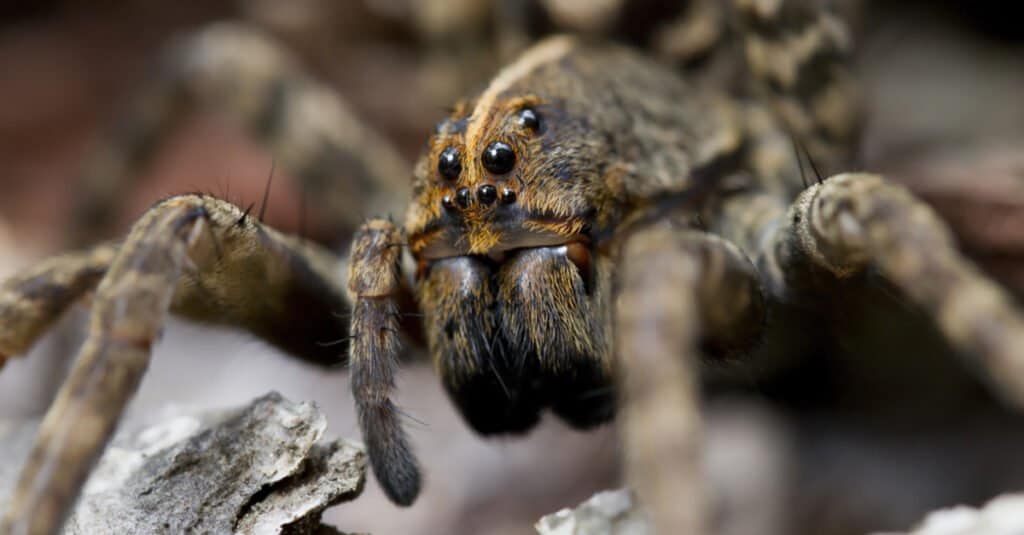
The Carolina wolf spider is a large and powerful spider.
©Will E. Davis/Shutterstock.com
| Scientific Name | Size | Danger to Humans |
|---|---|---|
| Hogna carolinensis | 2-4 inches | The bite from this spider causes local pain and swelling. |
The Carolina wolf spider is one of the biggest spiders in Wisconsin, and it may be the biggest overall. Wolf spiders are scary to many people because they are large and fast, and they run around on the ground hunting prey rather than placidly waiting in a web.
These spiders vary in color from sandy brown to dark brown. They have two thick dark stripes running down their carapaces and a dark mark down their abdomen. All of those dark spots are bordered by light stripes, especially behind the spider’s eyes.
Wolf spiders like to hide under rocks, fallen trees, or any other hiding spot they can use to scope out their prey. They also make their way indoors to avoid the winter weather.
They’re usually found in basements and attics, bringing them into close contact with people. Wolf spider bites are painful and will swell because of the size of their fangs. However, they are only very harmful if the individual is allergic to their venom.
We’ve now covered five of the biggest spiders in Wisconsin, and it’s clear they’re not terribly dangerous. However, the northern black widow and the brown recluse are two spiders that can inflict grievous wounds on people. Learn how to recognize those spiders and make sure you avoid them. If you find one in your home, it’s best to exterminate it or have someone else perform that task on your behalf.
Summary Of The 5 Biggest Spiders In Wisconsin
| Rank | Spider | Size in Length |
|---|---|---|
| 1 | Carolina Wolf Spider | 2-4 inches |
| 2 | Striped Fishing Spider | 1- 2.4 inches |
| 3 | American Nursery Web Spider | 1-3 inches |
| 4 | Long-Bodied Cellar Spider | 1-2 inches |
| 5 | Trapdoor Spider | 1-2 inches |
The photo featured at the top of this post is © Will E. Davis/Shutterstock.com
Sources
- University of Arkansas, Available here: https://arthropod.uark.edu/trapdoor-spider/
- Frontiers, Available here: https://www.frontiersin.org/articles/10.3389/fevo.2019.00256/full?&utm_source=Email_to_authors_&utm_medium=Email&utm_content=T1_11.5e1_author&utm_campaign=Email_publication&field=&journalName=Frontiers_in_Ecology_and_Evolution&id=462673
- University of Wisconsin (1970) uwm.edu/field-station/nursery-web-spider/
- Missouri Department of Conservation (1970) mdc.mo.gov/discover-nature/field-guide/striped-fishing-spider
Thank you for reading! Have some feedback for us? Contact the AZ Animals editorial team.






